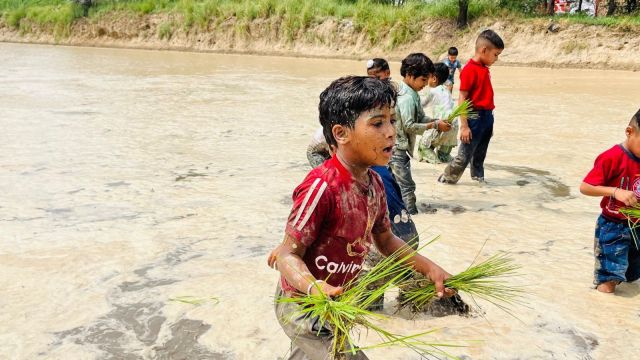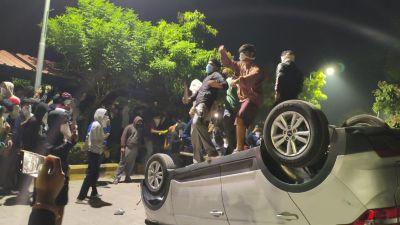What happens when you flip the script on traditional teaching methods and swap rote learning with playtime in paddy fields?
Across rural Punjab, Finland’s famous “happiness-first” education model is blossoming into real-life lessons in government primary schools. Instead of dreary classroom lectures, of late, these schools have been brimming with raucous laughter, excited chatter and backyard adventures.

Full of new ideas after a 15-day immersion programme at the University of Turku, a public university in Finland, the focus of Punjab’s government primary school teachers has shifted to what perhaps may be the truest test of learning: laughter.
Following in the footsteps of the earlier Aam Aadmi Party (AAP)-led government in Delhi, which started the programme in the national capital in 2023 to improve the standard of education in government schools, the party-led government in Punjab has been sending its primary teachers for similar training to the Nordic nation since 2024.
The first batch of 72 teachers from Punjab left for training in Finland on October 18, 2024. The second batch of 72 teachers left on March 15 this year, followed by the third batch of 72 teachers on November 15.
“Saving their childhood was our biggest lesson,” says Lavjeet Singh Grewal, head teacher, Government Primary School, Chananwal village, Fazilka district, who was a part of the October 2024 batch.
“They taught us that students need to breathe, play and refresh. Now, after every two periods, I give my students a short break. I have noticed that they return more focused on the next lesson. We won’t get Finnish infrastructure overnight, but we can certainly work on Finnish-style joy,” says Grewal, who teaches all subjects to students from pre-primary to Class 5.
Story continues below this ad
 Children from Govt Primary School, Dunera, Pathankot pose with a Jumbo, a new student made from balloons. (Express photo)
Children from Govt Primary School, Dunera, Pathankot pose with a Jumbo, a new student made from balloons. (Express photo)
Besides improved attention span, lessons have moved beyond the blackboard at this school.
In July, Grewal and his colleagues took students from pre-primary to Class 2 to a paddy field during the transplantation season “since parents usually stop their children from playing in soil”.
“We wanted the children to feel attached to their roots since most belong to farmer families. The students were allowed to tear through the field, which was full of water and mud, in their uniforms and see how paddy is transplanted. The learning in the field that day was far richer than a hundred lectures,” he says.
For students of Classes 3-5, the school organised a different activity.
Story continues below this ad
“They were taken to areas that were flood-hit (in August-September). In EVS (environmental studies), they learn how deforestation causes floods. The visit demonstrated this practically — areas with a sparse tree cover were more flooded compared to other places,” says Grewal.
 New admissions being welcomed with a cake at GPS, Dunera, Pathankot. (Express photo)
New admissions being welcomed with a cake at GPS, Dunera, Pathankot. (Express photo)
Even stereotypes are being given the boot. “In Finland, boys sew, girls weld. Everyone learns life skills there. We plan to embrace that here too,” he adds.
At the Government Primary School at Kapoori village in Patiala district, head teacher Jagjeet Walia now starts the day by having conversations with his students.
“Earlier, the assembly only had formal elements, like prayers, etc. Now, we converse with the students — about how they should behave with their parents, siblings, etc.,” says Walia, who went to Finland in October 2024.
Story continues below this ad
The school has also started ‘Mom Workshops’ to ensure that mothers, most of whom are home-makers who dropped out of school after marriage, develop an interest in what their children do in school.
“In these workshops, the mothers participate in activities like puzzle solving, colouring, etc., with their children,” he adds.
Stating that he was in the process of setting up a psychometric lab to individually chart each student’s strengths, Walia says, “Learning doesn’t mean filling notebooks, even if parents think so. Books have now taken a back seat to colouring, clay modelling and comfort. We want school to be a place that children look forward to.”
Other lessons from the Finland training too are being applied in Punjab schools.
Story continues below this ad
Satnam Singh, incharge, Government Primary School, Dhakoran, Mohali district, lets his students take charge on days they don’t feel like studying.
 Children from Government Primary School, Chananwal, Fazilka, having fun in paddy fields. (Express photo)
Children from Government Primary School, Chananwal, Fazilka, having fun in paddy fields. (Express photo)
“I let them paint or play with clay. After every few periods, I let them take a break — just like in Finland. These breaks have improved their creativity and concentration,” he says.
For Punjab’s youngest learners — the pre-primary students who learn basic concepts like numbers and colours at the local anganwadis before starting formal school — the teachers are taking various steps to put them at ease.
On November 14 (Children’s Day), the Government Primary School, Dunera village, Pathankot district, organised a “fun activity” by old students to welcome the newcomers.
Story continues below this ad
Head teacher Kavinder Kumar, also the cluster head teacher mentoring 10 schools, says, “Jumbo, a ‘student’ made out of balloons by old students, was used to welcome the newcomers. We wanted the newcomers to feel excited about returning to school the next morning. Usually, new pre-primary students are cranky for the first few days.”
Kumar adds, “Finland taught me that comfort means higher attendance and happier mornings. So we ensure that all newcomers are familiar with the campus layout.”
 Children playing at government primary school, Chananwal. (Express photo)
Children playing at government primary school, Chananwal. (Express photo)
On his takeaways from his Finland training, Jaspreet Singh, currently posted at a senior secondary school in Fatehgarh Sahib district, says, “Finnish child care centres are attached to schools. At these centres, they have nap time for children, besides capping the class strength at 20 students per teacher.”
Promoted since his return from Finland, Singh said he was struck not just by the world-class infrastructure there, but also by the sheer warmth. “Strictness was never a part of their recipe. They bring out the best in every child by being flexible, gentle and endlessly encouraging.”
Story continues below this ad
Punjab Education Secretary Anindita Mitra said the government is taking steps to institutionalise these “positive” changes.
“We have prepared a schedule that will be followed by all Finland-returned teachers from January 2026 onwards to train their counterparts. We are also working on a plan for content sharing with Finland to exchange learning material,” she says.



 Children from Govt Primary School, Dunera, Pathankot pose with a Jumbo, a new student made from balloons. (Express photo)
Children from Govt Primary School, Dunera, Pathankot pose with a Jumbo, a new student made from balloons. (Express photo) New admissions being welcomed with a cake at GPS, Dunera, Pathankot. (Express photo)
New admissions being welcomed with a cake at GPS, Dunera, Pathankot. (Express photo) Children from Government Primary School, Chananwal, Fazilka, having fun in paddy fields. (Express photo)
Children from Government Primary School, Chananwal, Fazilka, having fun in paddy fields. (Express photo) Children playing at government primary school, Chananwal. (Express photo)
Children playing at government primary school, Chananwal. (Express photo)





